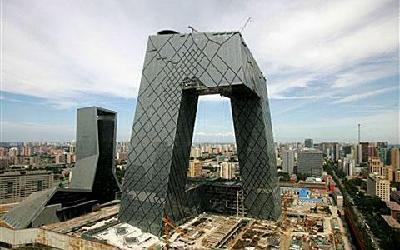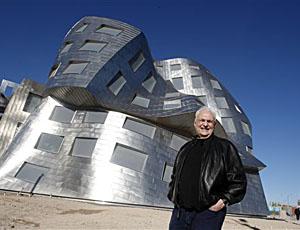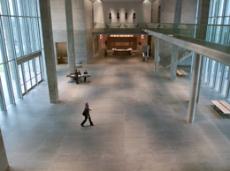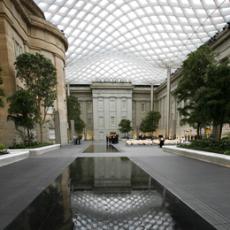
STEVE EMBER: I'm Steve Ember.
SHIRLEY GRIFFITH: And I'm Shirley Griffith with EXPLORATIONS in VOA Special English. Today we tell about six building designers widely considered some of the top architects at work today. They are Frank Gehry, Tadao Ando, Zaha Hadid, Rem Koolhaas, Norman Foster and Eduardo Souta de Moura. They have all created important examples of modern architecture. You can see their energizing and imaginative contributions to modern design in buildings around the world.
(MUSIC)
STEVE EMBER: We start with a designer who just won a top building design honor. Eduardo Souta de Moura of Portugal was named the winner of the 2011 Pritzker Architecture Prize. The jury praised him for creating works that are of our time, but also respectful of architectural traditions. His projects include single family homes, hotels, museums, schools and sports centers.
One example is the Burgo Tower in Porto, Portugal. It is made up of two buildings side by side. One building is horizontal, stretching from left to right. The other is vertical, rising up to the sky. The buildings' many windows create a striking surface. Pritzker jurists said Eduardo Souta de Moura's work is filled with intelligence and seriousness. They said it requires intense study, not a quick look.
(MUSIC)
SHIRLEY GRIFFITH: Frank Gehry grew up in Canada. In his free time as a child, he would make small versions of buildings out of pieces of wood. In 1947, his family moved to the United States. That is where Frank Gehry began his university studies in architecture.
He believes that architecture is art. He has said that, in some ways, he has been more influenced by artists and sculptors than by architects. This may be why his buildings often look like energetic sculptures made from bold geometric forms.
STEVE EMBER: Famous examples of Frank Gehry's work include the "Dancing House" in Prague, the capital of the Czech Republic. This playful building, finished in 1996, looks like two dancers.
His most famous building is the Guggenheim Museum in Bilbao, Spain. It was completed in 1997. Most of the curving building is covered in titanium. It looks like a dancing metal wave sitting on the edge of a river. The curved surfaces of this building and others by Frank Gehry are so complex to build that they require computer programs.
SHIRLEY GRIFFITH: More recently, he designed the Cleveland Clinic Lou Ruvo Center for Brain Health in Las Vegas, Nevada. It is a wavy metallic building with nearly 200 windows that sit at unexpected angles.

Frank Gehry's buildings are so popular that some people say they create a "Gehry effect." This term is used for a building that attracts visitors because of the architect who designed it.
(MUSIC)
STEVE EMBER: You might not think that a parking area near a tram station would be the project of one of the most famous names in modern architecture. But the car park and terminus in Strasbourg, France are a good example of the skill and creativity of Zaha Hadid. This parking area for 700 cars is a play of energetic lines. Nearby, the futuristic tram station is made up of sharp angles and geometric shapes.
VOICE TWO: Zaha Hadid has designed other striking buildings like the Guangzhou Opera House in China. Its rooms look like the inside of a beautiful alien spaceship.
Zaha Hadid is known for designing and completing structures that seem almost impossible on paper. She says that architecture is clearly about shelter, but it must also bring pleasure.
STEVE EMBER: Born in Iraq, Zaha Hadid completed her architectural studies in Britain, where she now lives. In 2004, she became the first woman to win the Pritzker Prize for architecture. Thomas Pritzker presented the award. He said that her work organizes land, space, structure, and person so that each is inseparable from the other, and each calls to the other.
Zaha Hadid and her architects have a number of current projects. They include the Glasgow Riverside Museum of Transport, and the Eli and Edythe Broad Art Museum at Michigan State University.
(MUSIC)
SHIRLEY GRIFFITH: Tadao Ando is a Japanese architect who has mainly worked in and around his city of Osaka. He never studied for a degree in architecture. Instead, he taught himself about modern architecture by visiting buildings and reading books.
Tadao Ando's first projects were houses. In 1993, he won Japan's Culture Design Prize for the Rokko housing project. These simple but striking concrete houses are built along the side of a hill overlooking Osaka Bay.
STEVE EMBER: Tadao Ando is known for using unfinished reinforced concrete as a building material. And he is known for making buildings with simple designs that are closely connected to the natural environment.
He says that when you create a building, you cannot simply put something new in a place. He says you have to understand what you see around you, what is on the land. He says you must use that knowledge along with modern thinking to plan a building design.

SHIRLEY GRIFFITH: Tadao Ando built the Church of Light in Osaka. This religious center is very simple in its design, but very beautiful. The main room is made of concrete. There is nothing on the walls except an opening in the concrete. The opening creates two bars of light in the form of a cross.
In 2002, his Modern Art Museum opened in Fort Worth, Texas. The building is so striking that you have to remind yourself to also look at the art. The concrete and glass museum is built next to a body of water, so it almost seems to float. The glass walls let natural light into the space while letting visitors look out across the water to see the city.
Tadao Ando also designed the Stone Hill Center at the Sterling and Francine Clark Art Institute in Massachusetts. The grey concrete and metal building is built into a hill. Its design expresses a sense of calm and simple beauty.
(MUSIC)
STEVE EMBER: Architect Rem Koolhaas is from the Netherlands. He began his career as a writer. He became well known for his writings about architecture long before he began making buildings. His book "Delirious Manhattan" is recognized as an important study of modern architecture and society.
Rem Koolhaas has designed houses, and cultural and educational buildings. He designed the Seattle Central Library in the state of Washington. It is an angular glass building with several levels that do not seem to fit together. Yet inside, the library has a free-flowing space that seems useful and orderly.
SHIRLEY GRIFFITH: Rem Koolhaas also designed the new headquarters of Central Chinese Television in Beijing. This building has two towers that rise in different directions from the ground. But they come together at the top of the building. It is a very unusual structure, one that appears to be bent out of shape.
Rem Koolhaas received the Pritzker Prize in 2000. Jurists said he uses his creative skills to create architecture that is as much about ideas as it is buildings.
STEVE EMBER: Norman Foster is known for his extremely high-tech and modern buildings. The British architect created the company Foster and Partners. He and his team have designed major buildings all over the world. These include the new German Parliament in Berlin, London's City Hall, the Milllau Viaduct in France and the Beijing Airport. His "30 St. Mary Axe" building in London is commonly known as the Gherkin or Cucumber building. It is shaped like a huge glass and metal cucumber.

SHIRLEY GRIFFITH: Norman Foster and his team designed a courtyard close to VOA's headquarters in Washington. They created a roof to cover what was once an outdoor area within the 19th century Old Patent Office Building. This building is home to two museums: the Smithsonian's National Portrait Gallery and American Art Museum. Norman Foster designed a roof that is a wavy surface of metal and glass. His design honors the traditional architecture of the museum, while also adding a modern touch.
Foster and Partners is also to build one of several buildings that will make up the new World Trade Center area in New York.
STEVE EMBER: We did not have time to talk about all the other imaginative architects at work today. But the works of Frank Gehry, Tadao Ando, Zaha Hadid, Rem Koolhaas, Norman Foster and Eduardo Souta de Moura are a good start for learning about modern building design.
(MUSIC)
SHIRLEY GRIFFITH: This program was written and produced by Dana Demange. I'm Shirley Griffith.
STEVE EMBER: And I'm Steve Ember. Join us again next week for EXPLORATIONS in VOA Special English.
Some of world's most famous buildings, all in one museum
目瞪口呆的創(chuàng)意:世界十一大超級(jí)古怪建筑
(來(lái)源:VOA 編輯:崔旭燕)
